The Impact of Social Media Marketing on Brand Loyalty: Australia
VerifiedAdded on 2023/06/08
|7
|1310
|349
Report
AI Summary
This report investigates the impact of social media marketing on brand loyalty within Australian organizations. The research begins with a problem statement highlighting the importance of brand loyalty and the rise of social media marketing. The report outlines the research aim, objectives, and methodology, including data collection methods (primary and secondary), sample selection, and data analysis techniques. Ethical considerations are addressed, ensuring data integrity and confidentiality. A Gantt chart provides a timeline for the research process. The expected outcome is to understand the positive and negative effects of social media marketing on brand loyalty and provide recommendations for improvement. The report includes a reference list and bibliography, citing relevant academic sources to support the findings and conclusions. This comprehensive analysis aims to provide valuable insights for marketers and organizations seeking to leverage social media for enhanced brand loyalty in the Australian market.
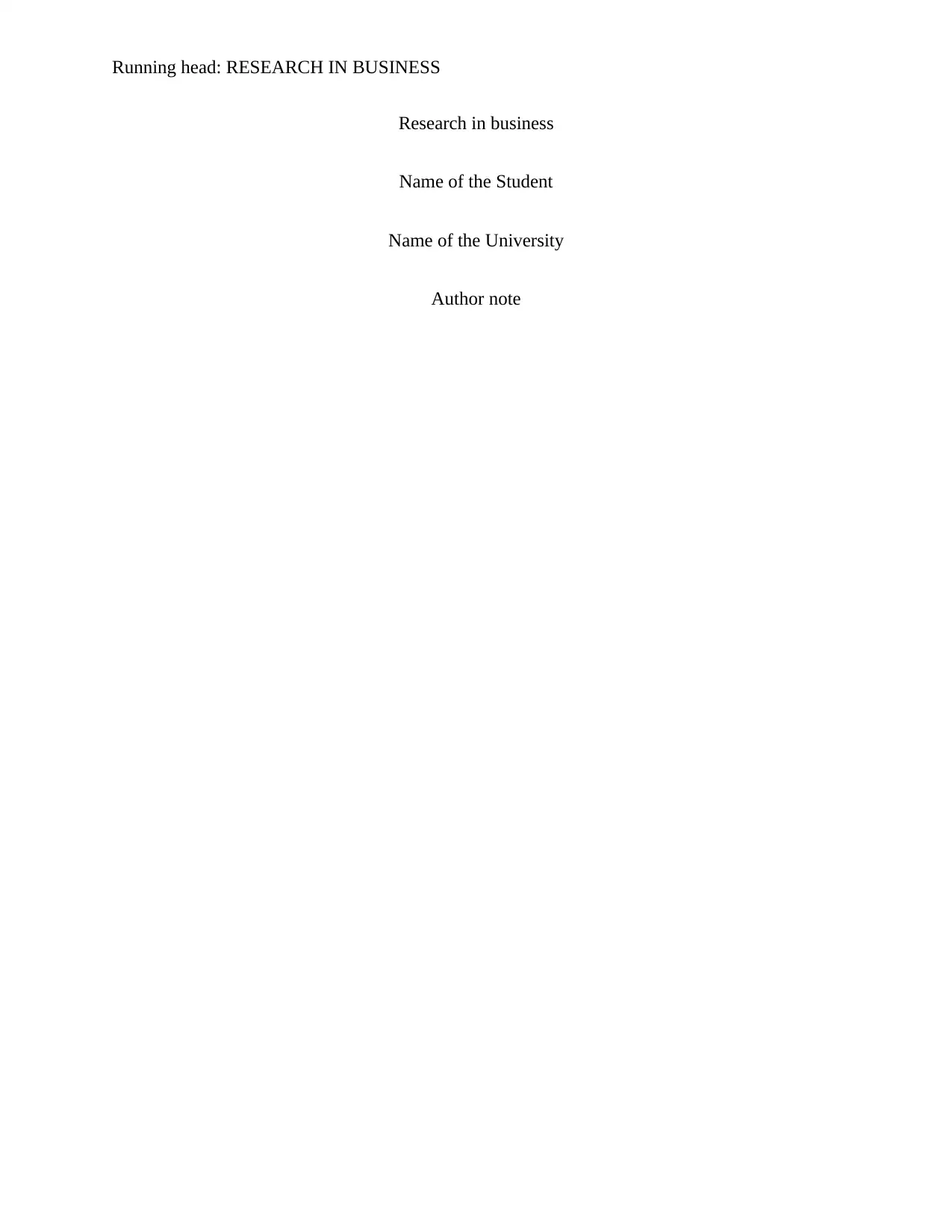
Running head: RESEARCH IN BUSINESS
Research in business
Name of the Student
Name of the University
Author note
Research in business
Name of the Student
Name of the University
Author note
Paraphrase This Document
Need a fresh take? Get an instant paraphrase of this document with our AI Paraphraser

1RESEARCH IN BUSINESS
1. Title of the project: Effect of social media on brand loyalty
2. Problem statement:
For a prolonged period of time, developing and sustaining brand loyalty are two of the
highly crucial factors of market research (Erdoğmuş & Cicek, 2014). Market research utilizes
various tools to monitor and maintain the brand loyalty in the market segment. With the
emergence of internet, social media marketing have huge popularity as a mean to maintain brand
loyalty of the consumers (Laroche, Habibi & Richard, 2013). Marketers are found to invest a
huge amount of time as well as money on social media sites in order to develop and maintain
brand loyalty (Balakrishnan, Dahnil and Yi, 2014). However, according to a good number of
researchers, marketing through social media has the potential to adversely affect the brand
loyalty of the consumers (Hollebeek, Glynn & Brodie, 2014). The purpose of the report is to find
out the degree to which social media marketing is viable for enhancing and maintaining the
brand loyalty of the organizations in Australia.
3. Research aim and objectives
The chief aim of the research is to identify and evaluate the impact of social media marketing on
brand loyalty of Australian organization. The research objectives are as follows:
To find out the beneficial effects of social media marketing on brand loyalty of
Australian organization
To discover out how social media marketing adversely affects the brand loyalty of an
organization.
To provide effective recommendation for eradicating the negative effect of social media
marketing on brand equity
1. Title of the project: Effect of social media on brand loyalty
2. Problem statement:
For a prolonged period of time, developing and sustaining brand loyalty are two of the
highly crucial factors of market research (Erdoğmuş & Cicek, 2014). Market research utilizes
various tools to monitor and maintain the brand loyalty in the market segment. With the
emergence of internet, social media marketing have huge popularity as a mean to maintain brand
loyalty of the consumers (Laroche, Habibi & Richard, 2013). Marketers are found to invest a
huge amount of time as well as money on social media sites in order to develop and maintain
brand loyalty (Balakrishnan, Dahnil and Yi, 2014). However, according to a good number of
researchers, marketing through social media has the potential to adversely affect the brand
loyalty of the consumers (Hollebeek, Glynn & Brodie, 2014). The purpose of the report is to find
out the degree to which social media marketing is viable for enhancing and maintaining the
brand loyalty of the organizations in Australia.
3. Research aim and objectives
The chief aim of the research is to identify and evaluate the impact of social media marketing on
brand loyalty of Australian organization. The research objectives are as follows:
To find out the beneficial effects of social media marketing on brand loyalty of
Australian organization
To discover out how social media marketing adversely affects the brand loyalty of an
organization.
To provide effective recommendation for eradicating the negative effect of social media
marketing on brand equity
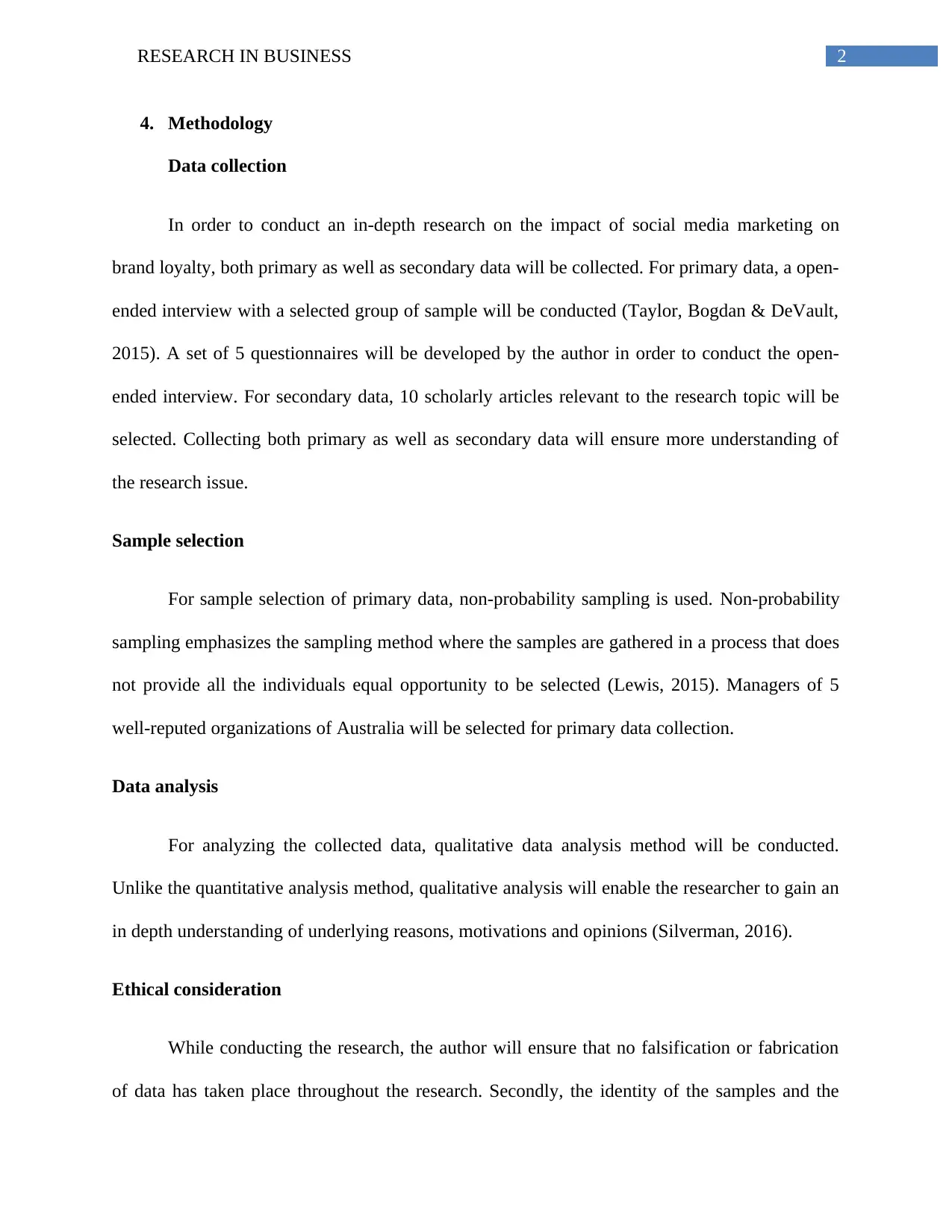
2RESEARCH IN BUSINESS
4. Methodology
Data collection
In order to conduct an in-depth research on the impact of social media marketing on
brand loyalty, both primary as well as secondary data will be collected. For primary data, a open-
ended interview with a selected group of sample will be conducted (Taylor, Bogdan & DeVault,
2015). A set of 5 questionnaires will be developed by the author in order to conduct the open-
ended interview. For secondary data, 10 scholarly articles relevant to the research topic will be
selected. Collecting both primary as well as secondary data will ensure more understanding of
the research issue.
Sample selection
For sample selection of primary data, non-probability sampling is used. Non-probability
sampling emphasizes the sampling method where the samples are gathered in a process that does
not provide all the individuals equal opportunity to be selected (Lewis, 2015). Managers of 5
well-reputed organizations of Australia will be selected for primary data collection.
Data analysis
For analyzing the collected data, qualitative data analysis method will be conducted.
Unlike the quantitative analysis method, qualitative analysis will enable the researcher to gain an
in depth understanding of underlying reasons, motivations and opinions (Silverman, 2016).
Ethical consideration
While conducting the research, the author will ensure that no falsification or fabrication
of data has taken place throughout the research. Secondly, the identity of the samples and the
4. Methodology
Data collection
In order to conduct an in-depth research on the impact of social media marketing on
brand loyalty, both primary as well as secondary data will be collected. For primary data, a open-
ended interview with a selected group of sample will be conducted (Taylor, Bogdan & DeVault,
2015). A set of 5 questionnaires will be developed by the author in order to conduct the open-
ended interview. For secondary data, 10 scholarly articles relevant to the research topic will be
selected. Collecting both primary as well as secondary data will ensure more understanding of
the research issue.
Sample selection
For sample selection of primary data, non-probability sampling is used. Non-probability
sampling emphasizes the sampling method where the samples are gathered in a process that does
not provide all the individuals equal opportunity to be selected (Lewis, 2015). Managers of 5
well-reputed organizations of Australia will be selected for primary data collection.
Data analysis
For analyzing the collected data, qualitative data analysis method will be conducted.
Unlike the quantitative analysis method, qualitative analysis will enable the researcher to gain an
in depth understanding of underlying reasons, motivations and opinions (Silverman, 2016).
Ethical consideration
While conducting the research, the author will ensure that no falsification or fabrication
of data has taken place throughout the research. Secondly, the identity of the samples and the
⊘ This is a preview!⊘
Do you want full access?
Subscribe today to unlock all pages.

Trusted by 1+ million students worldwide
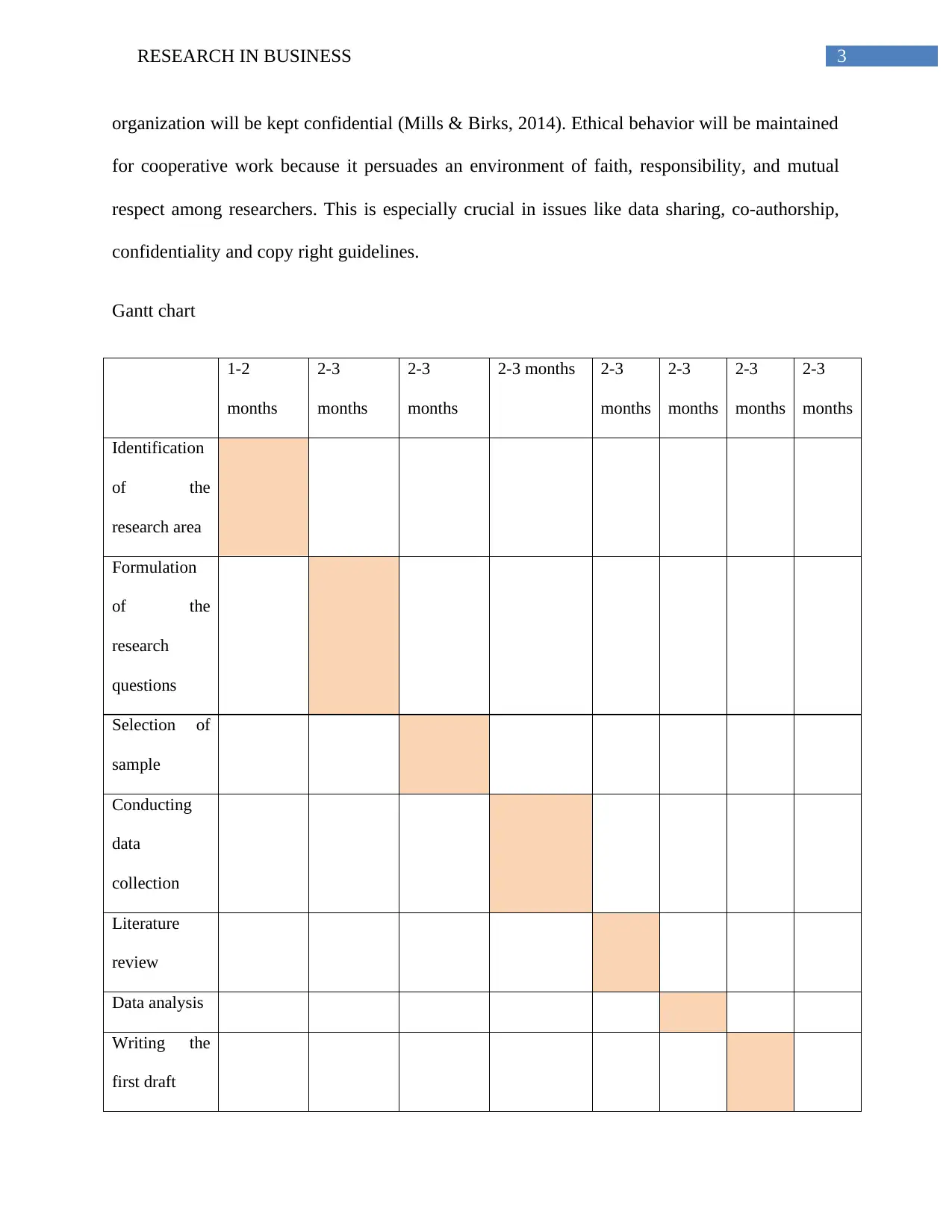
3RESEARCH IN BUSINESS
organization will be kept confidential (Mills & Birks, 2014). Ethical behavior will be maintained
for cooperative work because it persuades an environment of faith, responsibility, and mutual
respect among researchers. This is especially crucial in issues like data sharing, co-authorship,
confidentiality and copy right guidelines.
Gantt chart
1-2
months
2-3
months
2-3
months
2-3 months 2-3
months
2-3
months
2-3
months
2-3
months
Identification
of the
research area
Formulation
of the
research
questions
Selection of
sample
Conducting
data
collection
Literature
review
Data analysis
Writing the
first draft
organization will be kept confidential (Mills & Birks, 2014). Ethical behavior will be maintained
for cooperative work because it persuades an environment of faith, responsibility, and mutual
respect among researchers. This is especially crucial in issues like data sharing, co-authorship,
confidentiality and copy right guidelines.
Gantt chart
1-2
months
2-3
months
2-3
months
2-3 months 2-3
months
2-3
months
2-3
months
2-3
months
Identification
of the
research area
Formulation
of the
research
questions
Selection of
sample
Conducting
data
collection
Literature
review
Data analysis
Writing the
first draft
Paraphrase This Document
Need a fresh take? Get an instant paraphrase of this document with our AI Paraphraser
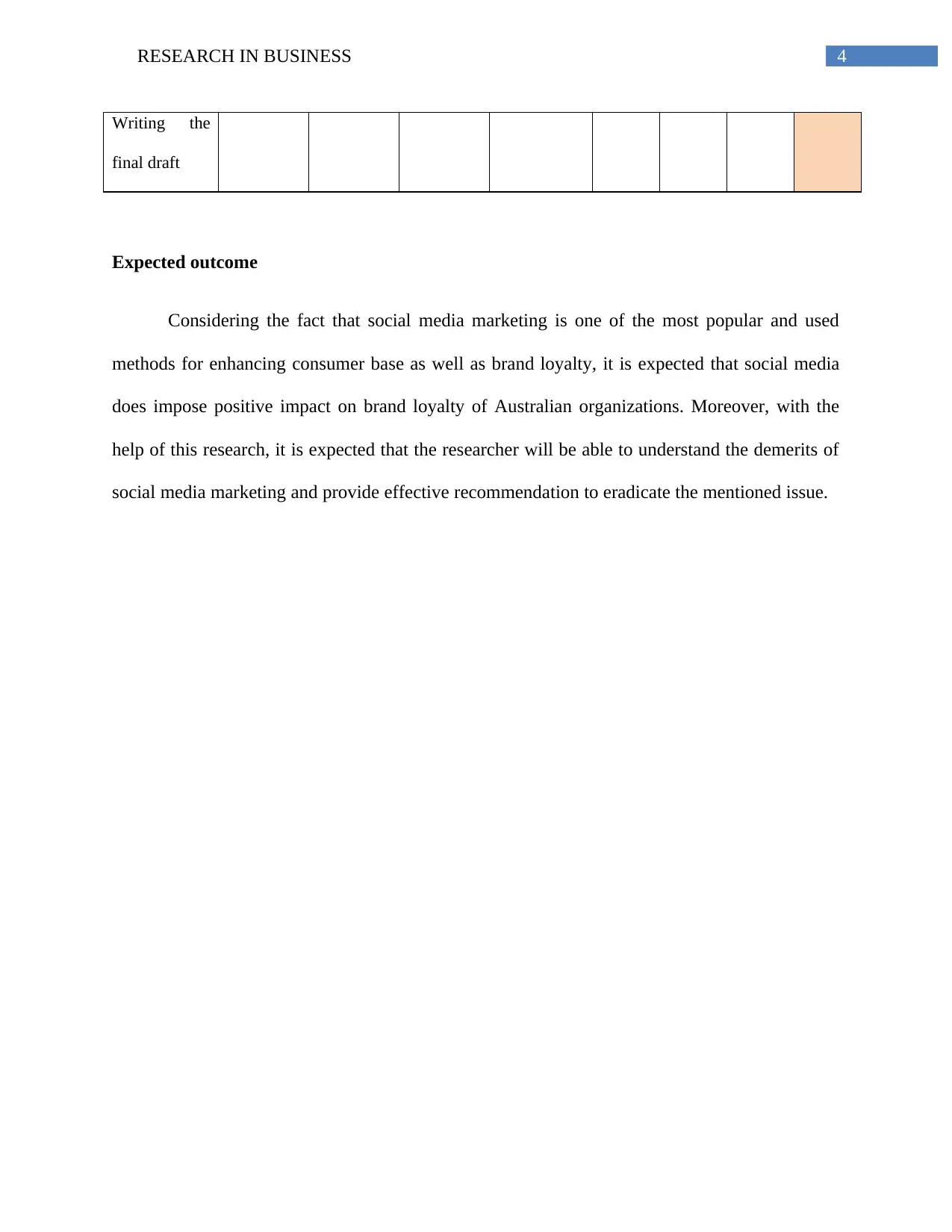
4RESEARCH IN BUSINESS
Writing the
final draft
Expected outcome
Considering the fact that social media marketing is one of the most popular and used
methods for enhancing consumer base as well as brand loyalty, it is expected that social media
does impose positive impact on brand loyalty of Australian organizations. Moreover, with the
help of this research, it is expected that the researcher will be able to understand the demerits of
social media marketing and provide effective recommendation to eradicate the mentioned issue.
Writing the
final draft
Expected outcome
Considering the fact that social media marketing is one of the most popular and used
methods for enhancing consumer base as well as brand loyalty, it is expected that social media
does impose positive impact on brand loyalty of Australian organizations. Moreover, with the
help of this research, it is expected that the researcher will be able to understand the demerits of
social media marketing and provide effective recommendation to eradicate the mentioned issue.
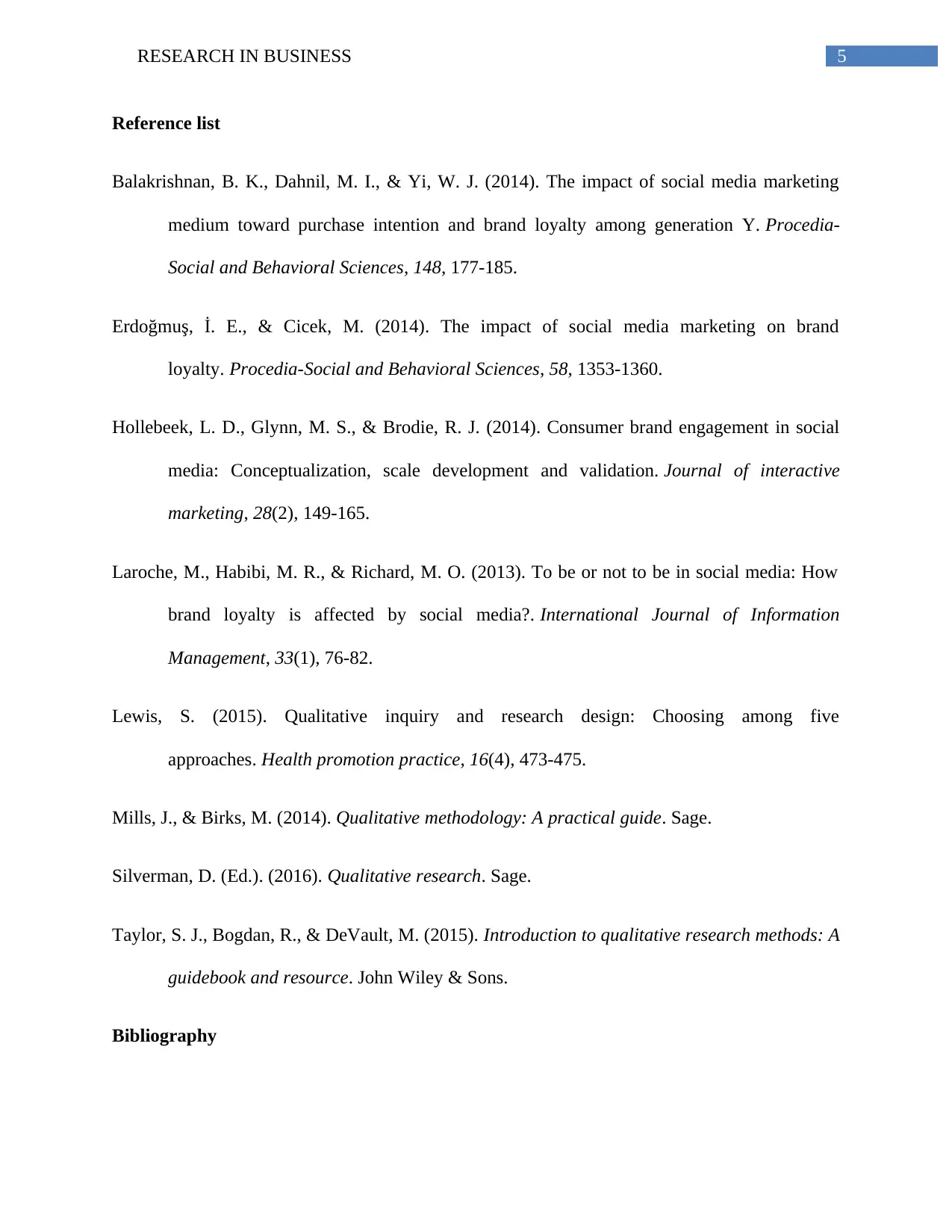
5RESEARCH IN BUSINESS
Reference list
Balakrishnan, B. K., Dahnil, M. I., & Yi, W. J. (2014). The impact of social media marketing
medium toward purchase intention and brand loyalty among generation Y. Procedia-
Social and Behavioral Sciences, 148, 177-185.
Erdoğmuş, İ. E., & Cicek, M. (2014). The impact of social media marketing on brand
loyalty. Procedia-Social and Behavioral Sciences, 58, 1353-1360.
Hollebeek, L. D., Glynn, M. S., & Brodie, R. J. (2014). Consumer brand engagement in social
media: Conceptualization, scale development and validation. Journal of interactive
marketing, 28(2), 149-165.
Laroche, M., Habibi, M. R., & Richard, M. O. (2013). To be or not to be in social media: How
brand loyalty is affected by social media?. International Journal of Information
Management, 33(1), 76-82.
Lewis, S. (2015). Qualitative inquiry and research design: Choosing among five
approaches. Health promotion practice, 16(4), 473-475.
Mills, J., & Birks, M. (2014). Qualitative methodology: A practical guide. Sage.
Silverman, D. (Ed.). (2016). Qualitative research. Sage.
Taylor, S. J., Bogdan, R., & DeVault, M. (2015). Introduction to qualitative research methods: A
guidebook and resource. John Wiley & Sons.
Bibliography
Reference list
Balakrishnan, B. K., Dahnil, M. I., & Yi, W. J. (2014). The impact of social media marketing
medium toward purchase intention and brand loyalty among generation Y. Procedia-
Social and Behavioral Sciences, 148, 177-185.
Erdoğmuş, İ. E., & Cicek, M. (2014). The impact of social media marketing on brand
loyalty. Procedia-Social and Behavioral Sciences, 58, 1353-1360.
Hollebeek, L. D., Glynn, M. S., & Brodie, R. J. (2014). Consumer brand engagement in social
media: Conceptualization, scale development and validation. Journal of interactive
marketing, 28(2), 149-165.
Laroche, M., Habibi, M. R., & Richard, M. O. (2013). To be or not to be in social media: How
brand loyalty is affected by social media?. International Journal of Information
Management, 33(1), 76-82.
Lewis, S. (2015). Qualitative inquiry and research design: Choosing among five
approaches. Health promotion practice, 16(4), 473-475.
Mills, J., & Birks, M. (2014). Qualitative methodology: A practical guide. Sage.
Silverman, D. (Ed.). (2016). Qualitative research. Sage.
Taylor, S. J., Bogdan, R., & DeVault, M. (2015). Introduction to qualitative research methods: A
guidebook and resource. John Wiley & Sons.
Bibliography
⊘ This is a preview!⊘
Do you want full access?
Subscribe today to unlock all pages.

Trusted by 1+ million students worldwide
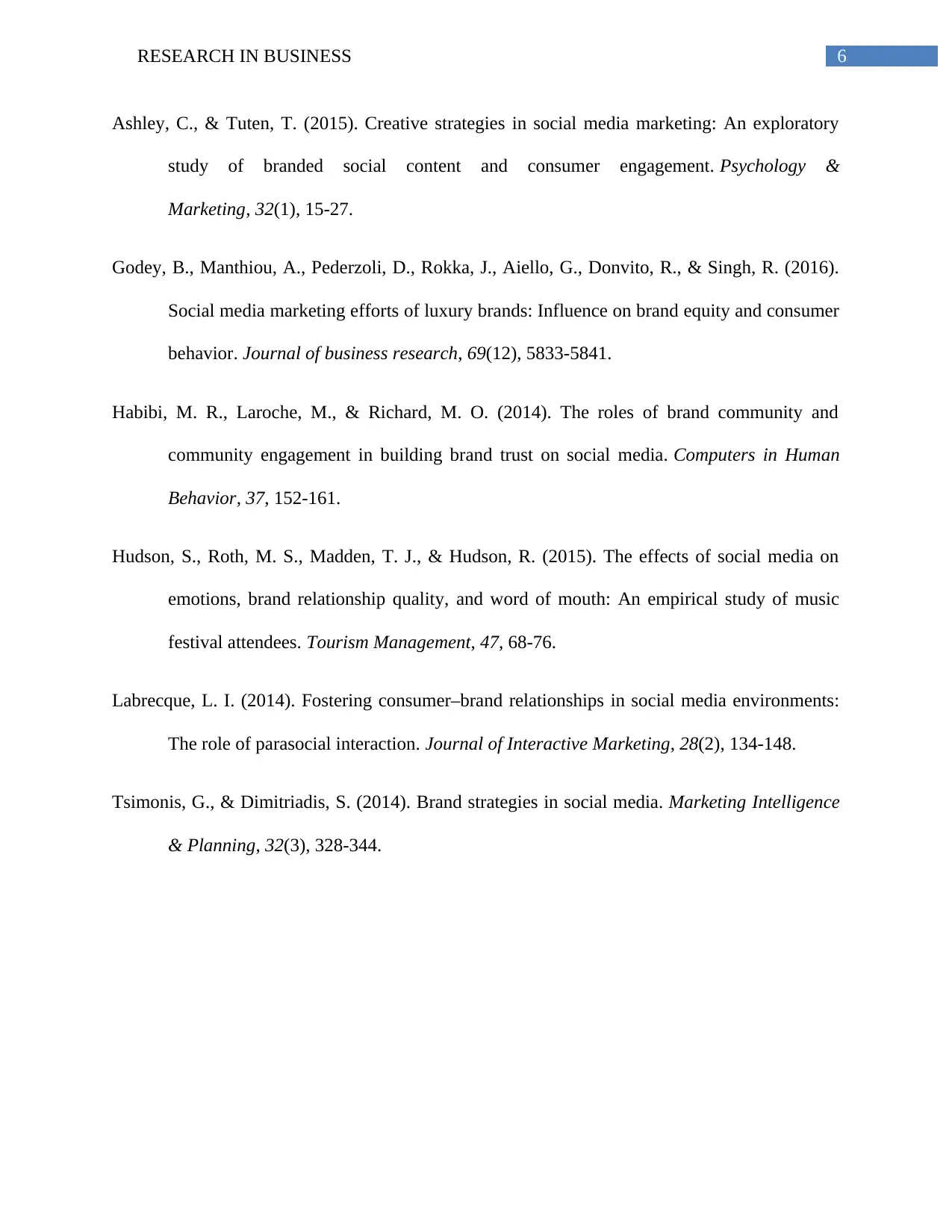
6RESEARCH IN BUSINESS
Ashley, C., & Tuten, T. (2015). Creative strategies in social media marketing: An exploratory
study of branded social content and consumer engagement. Psychology &
Marketing, 32(1), 15-27.
Godey, B., Manthiou, A., Pederzoli, D., Rokka, J., Aiello, G., Donvito, R., & Singh, R. (2016).
Social media marketing efforts of luxury brands: Influence on brand equity and consumer
behavior. Journal of business research, 69(12), 5833-5841.
Habibi, M. R., Laroche, M., & Richard, M. O. (2014). The roles of brand community and
community engagement in building brand trust on social media. Computers in Human
Behavior, 37, 152-161.
Hudson, S., Roth, M. S., Madden, T. J., & Hudson, R. (2015). The effects of social media on
emotions, brand relationship quality, and word of mouth: An empirical study of music
festival attendees. Tourism Management, 47, 68-76.
Labrecque, L. I. (2014). Fostering consumer–brand relationships in social media environments:
The role of parasocial interaction. Journal of Interactive Marketing, 28(2), 134-148.
Tsimonis, G., & Dimitriadis, S. (2014). Brand strategies in social media. Marketing Intelligence
& Planning, 32(3), 328-344.
Ashley, C., & Tuten, T. (2015). Creative strategies in social media marketing: An exploratory
study of branded social content and consumer engagement. Psychology &
Marketing, 32(1), 15-27.
Godey, B., Manthiou, A., Pederzoli, D., Rokka, J., Aiello, G., Donvito, R., & Singh, R. (2016).
Social media marketing efforts of luxury brands: Influence on brand equity and consumer
behavior. Journal of business research, 69(12), 5833-5841.
Habibi, M. R., Laroche, M., & Richard, M. O. (2014). The roles of brand community and
community engagement in building brand trust on social media. Computers in Human
Behavior, 37, 152-161.
Hudson, S., Roth, M. S., Madden, T. J., & Hudson, R. (2015). The effects of social media on
emotions, brand relationship quality, and word of mouth: An empirical study of music
festival attendees. Tourism Management, 47, 68-76.
Labrecque, L. I. (2014). Fostering consumer–brand relationships in social media environments:
The role of parasocial interaction. Journal of Interactive Marketing, 28(2), 134-148.
Tsimonis, G., & Dimitriadis, S. (2014). Brand strategies in social media. Marketing Intelligence
& Planning, 32(3), 328-344.
1 out of 7
Related Documents
Your All-in-One AI-Powered Toolkit for Academic Success.
+13062052269
info@desklib.com
Available 24*7 on WhatsApp / Email
![[object Object]](/_next/static/media/star-bottom.7253800d.svg)
Unlock your academic potential
Copyright © 2020–2025 A2Z Services. All Rights Reserved. Developed and managed by ZUCOL.





